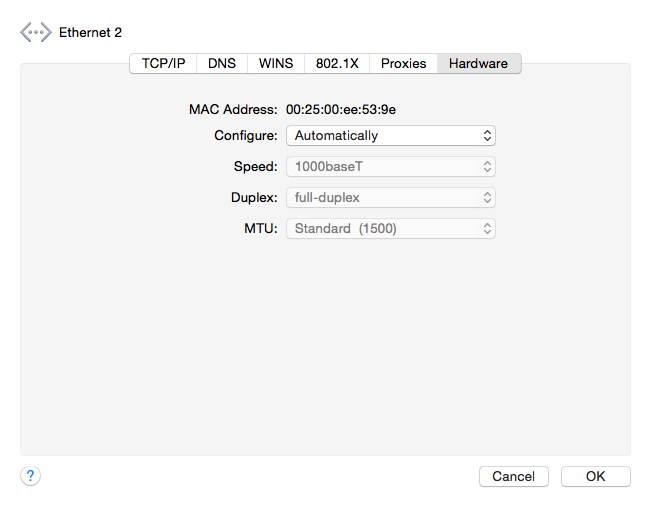Finding your MAC address
Your machine's MAC address is a network identifier for your computer, which uniquely identifies your computer on the network, and which is often used (1) when creating a licence for a specific computer, or (2) when registering a laptop on the network (one of these is probably why you're reading this page). It's the ‘ethernet address’ of your wired or wireless interface (though this is a bit of a misnomer). It's not in any way specific to Apple Macs (though Macs have MACs, too, and this is entertainingly distinct from MAC, for those of you keeping up at the back).
A MAC address consists of 12 characters from 0–9 and a–f, in pairs separated by
colons or dashes. For example 12:34:56:78:9a:bc or 12-34-56-78-9A-BC.
If you need to quote your MAC address, there are various ways you can do so, depending on your platform.
Notes:
- In each of the cases below, you should generally ensure that you are quoting a MAC address of an ethernet interface, and not a WiFi MAC address. If you're only quoting a MAC address for licensing purposes, it doesn't matter which one it is.
- If you connect to ethernet via a dongle of some type – for
example a USB-to-ethernet adapter – then the dongle will have the
MAC address (and it's technically the dongle that is given access
to the network, not your computer). Bear that in mind when
looking through the list of available interfaces on your
computer. If it's not obvious which one this is, just
cut-and-paste the entire
ifconfigoutput into an email and let IT staff do the detective-work.
Linux §
At a shell prompt, type ifconfig. This lists the
network interfaces which are available. There will typically be
one called eth0 or enp2s0f0, or something similar, depending on the distribution.
In this stanza, search for HWaddr or ether.
For example:
% ifconfig
eth0 Link encap:Ethernet HWaddr 00:25:90:59:9e:60
inet addr:130.209.45.115 Bcast:130.209.45.255 Mask:255.255.255.0
inet6 addr: fe80::225:90ff:fe59:9e60/64 Scope:Link
UP BROADCAST RUNNING MULTICAST MTU:1500 Metric:1
RX packets:152522807 errors:0 dropped:8050 overruns:2 frame:0
TX packets:167691945 errors:0 dropped:0 overruns:0 carrier:0
collisions:0 txqueuelen:1000
RX bytes:50057940479 (50.0 GB) TX bytes:21142845126 (21.1 GB)
Memory:dff60000-dff80000
eth1 Link encap:Ethernet HWaddr 00:25:90:59:9e:61
UP BROADCAST MULTICAST MTU:1500 Metric:1
RX packets:0 errors:0 dropped:0 overruns:0 frame:0
TX packets:0 errors:0 dropped:0 overruns:0 carrier:0
collisions:0 txqueuelen:1000
RX bytes:0 (0.0 B) TX bytes:0 (0.0 B)
Memory:dffe0000-e0000000
lo Link encap:Local Loopback
inet addr:127.0.0.1 Mask:255.0.0.0
inet6 addr: ::1/128 Scope:Host
UP LOOPBACK RUNNING MTU:16436 Metric:1
RX packets:1804940 errors:0 dropped:0 overruns:0 frame:0
TX packets:1804940 errors:0 dropped:0 overruns:0 carrier:0
collisions:0 txqueuelen:0
RX bytes:347380165 (347.3 MB) TX bytes:347380165 (347.3 MB)
Here, you can see that the eth0 interface has both a HWaddr and an
inet addr (IP address), marked in red.
This machine happens to have two interfaces – the other is called eth1.
In this case, it appears to be the eth0 interface that the user
connects to the network, and which is therefore the one to be quoted.
OS X/macOS §
You can use ifconfig at a shell prompt, as above (the ethernet and
wireless interfaces look like en0 and en1 on OS X).
Alternatively, you can go to the ‘Network’ preference pane, in System Preferences, then click on ‘Advanced...’, and find the ‘Hardware’ tab within that, to see your MAC address quoted as below:

Windows §
First, start a ‘command prompt’ (opening a command prompt is done in different ways on different versions of Windows, but should be something like: click Start, click Run, type cmd, and then click ‘OK’; Google is your friend).
Then type ipconfig /all and search through the output for ‘physical address’.
It might look something like this.
Connection-specific DNS Suffix . :
Description . . . . . . . . . . . : Qualcomm Atheros XXX Gigabit Ethernet Controller
Physical Address. . . . . . . . . : 12-34-56-78-9A-BC
DHCP Enabled. . . . . . . . . . . : No
Autoconfiguration Enabled . . . . : Yes
Link-local IPv6 Address . . . . . : fe80::1234:5678:9abc:12f%14(Preferred)
IPv4 Address. . . . . . . . . . . : 130.209.99.99(Preferred)
Subnet Mask . . . . . . . . . . . : 255.255.255.0
Default Gateway . . . . . . . . . : 130.209.99.1
DHCPv6 IAID . . . . . . . . . . . : 12345678
DHCPv6 Client DUID. . . . . . . . : 00-01-02-00-12-34-56-78-9A-BC-11-11-11-11
DNS Servers . . . . . . . . . . . : 130.209.4.16
130.209.4.18
NetBIOS over Tcpip. . . . . . . . : Enabled
There may be quite a lot of output here, especially if your machine has multiple network ports.
Try to quote an address which has an IPv4 Address associated with it, as here.
If you are trying to register a laptop, you will need to find the entry associated with the ‘ethernet’ port.
If in doubt, just cut-and-paste the entire ipconfig output into an email and let IT staff do the detective-work.
There are various ways of finding this ‘physical address’ through the windows GUI interface, but the above method is the most nearly cross-version.
